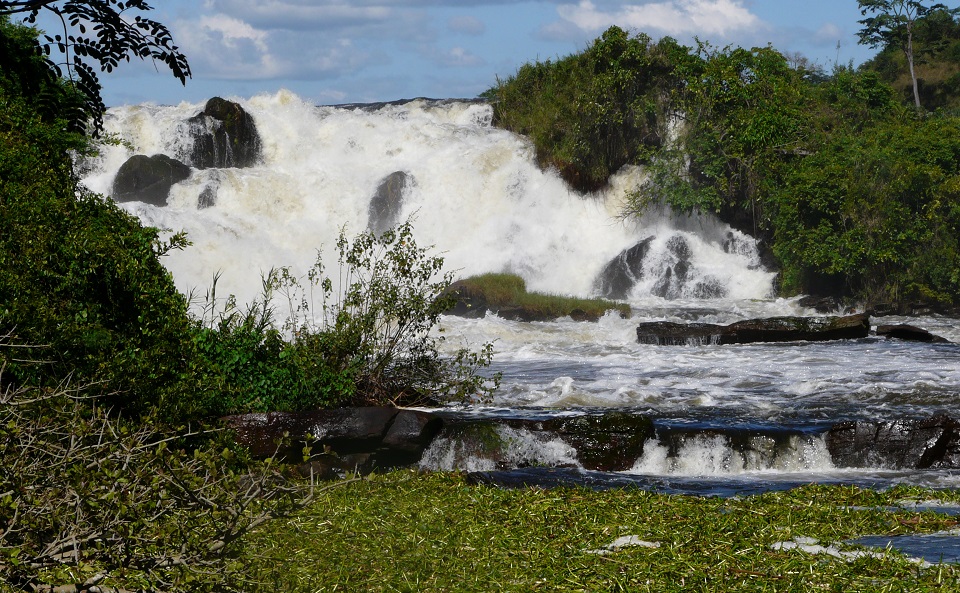
The Karuma Falls where the Karuma dam is planned constructed, photo: Mark Jordahl
Swizeen Ndyabawe
The Karuma project was conceived in the early 1990s as a potential to generate 200 megawatts (MW). In the mid-1990s, the Norwegian firm Norpak acquired exclusive rights to develop the project. Early 2008, Norpak pulled out after a protracted conflict with the World Bank. It handed the project designs, maps, ground investigations and other information over to the Ugandan government. The government made a decision to increase the capacity of the Karuma dam from 200MW to 600MW after feasibility studies in 2010 confirmed that the water flow could generated that amount of energy.
The project hit a snag in 2010. This was mainly due to the fact that residents of the area around the proposed site for the dam were not informed about the pre-feasibility studies and the drillings that were taking place in their plantations. This activity was going on without their consent therefore a conflict emerged. This created a negative impact on the project, hence a longer time frame than planned for. In future projects, this calls for consideration of the rights of the local people who are to be affected by dam projects in all three phases of a dam project that is planning, construction and operational.

Swizeen Ndyabawe is a grad student at the Center for human rights at the University of Oslo and has been an intern at the Fivas office, photo: Jonas Holmqvist
The Karuma project mostly used a public notice as the method of public involvement. This is troublesome since in rural areas, many people may be interested, but unable to reply to public notices due to illiteracy or lack of ready access to newspapers. Therefore public involvement can be increased through use of public meetings. In a public meeting, local people can voice their opinions, concerns and suggestions. This method can complement public notices and can be very effective in ensuring public involvement. It may also be appropriate to conduct interviews, focus group discussions and a series of workshops with the local people and their leaders to gain more in-depth information.
Long delay
Like the Bujagali project, complaints related to procurement process delayed the Karuma power project. In January 2013, Public Procurement and Disposal of Public Assets Authority (PPDA) suspended the process of tendering the power project. This was after the intervention of the Inspector General of Government on allegations that M/S China International Water & Electric (CWE), was passed on the technical stage based on misrepresented facts about its capacity to construct the dam. CWE was among the companies competing for the contract. A series of court injunctions and cancellations and a repetition of the technical evaluation processes as a result of petitions by construction companies which wanted open and fair competition for the contract led to a 2 year procurement delay. However, the government blamed the delay on certain elements bent on sabotaging economic progress. The president of Uganda attributed the delays to the mistakes of Ugandan professionals as well as the series of conditions imposed by development partners.
The Karuma dam project struggled to take off and this led to the increase in the construction price. Secrecy surrounded the process of Karuma dam construction right away from the planning stage, the public was initially denied access to the information about the whole process. The project will cost over $2 billion, 85% of the funding came from the Exim Bank of China as a soft loan while the Ugandan government provided 15% of the funding. In August 2013 President Yoweri Museveni commissioned the Karuma power project construction works and it is expected to come online by 2018. The project is being undertaken by SinoHydro Corp Ltd from China since 2013.
The initial plan was that Karuma would be a public project fully financed by the government of Uganda through the energy fund and oil revenues in order to provide cheap electricity and neutralise the high tariff. However this was not possible. On March 24, 2015, the parliament of Uganda had to approve the government’s request to borrow funds for the construction of the hydro power plant. The money will be payable over a 25 year period at an average 3% interest rate. The Energy Fund money is funding only 15% of Karuma Hydropower Project and the loan finances 85%.
Resettlement issues
Issues regarding the compensation and resettlement of residents who previous settled around Karuma area also threatened the commencement of the project. Early 2013, the residents filed a case in court over compensation and wanted an injunction on the project until their issues were looked into. According to the Environment and Social Impact Assessment of the dam, the total land required for the project was 465.52 hectares
In the mid-1990s, Norpak, the previous contractors, acquired some land and compensated the owners. But some more land was still required, it was to be acquired from locals residing in four villages in Mutunda and Kamdini sub counties in Kiryadongo and Oyam Districts respectively. However residents were bitter that the money being offered was too little and they vowed not to leave their land. The local leaders who were partly involved were also accused to be unfair to the community members because they had allegedly been bribed and they hurriedly did the work which worsened the compensation issues. Different rates were used in the same areas which contributed to the problem. This forced locals to reject the rates as very low, which attracted a legal battle in court between residents and the government that further delayed the project. A local independent Complaints committee should always be put in place before the project starts in order to settle the disputes and inequity in the compensation exercise in time for the projects to start in as planned. This is in line with Article 6 of the Indigenous and Tribal Peoples Convention, 1989 which emphasises the principle of proper consultation and participation of the affected people.
Failed to take lessons from Bujagali
Currently the Karuma project is once again embroiled in controversy, this time over an insurance contract. Sinohydro has failed to pay premiums to a consortium of 23 insurance and re-insurance companies, and is instead questioning the 2013 contract. National policy requires all national projects to be insured with Ugandan insurance companies as a way of reducing capital flight and help deepen the domestic financial system. However the contractor is uncomfortable with this arrangement. This disagreement means that component of the project is not insured and Uganda could lose in the event of a catastrophe.
The issues which negatively affected and delayed the construction of the Bujagali dam are almost the same issues which are affecting the construction of the Karuma dam. This therefore shows that the government of Uganda did not learn from the experience of Bujagali dam especially in the areas of procurement of contractors and compensation of the people to be affected by the dam. Uganda has to completely settle the abovementioned issues if it is to improve its energy sector and achieve universal electrification as stated in its Vision 2040 master plan.

